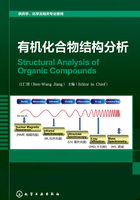
1.2 Major Spectroscopic Techniques
1.2.1 Absorption Spectrum
The energy states are said to be quantized because a photon of precise energy and frequency(or wavelength)must be absorbed to excite an electron or molecule from the ground state to a particular excited state.Since molecules have a unique set of energy states that depend on their structure,IR[28],UV-visible[29] and NMR spectroscopy[30] will provide valuable information about the structure of the molecule.
1.2.2 Diffraction
To “see” a molecule we need to use light having a wavelength smaller than the molecule itself(approximately 10-10m).Such radiation is found in the X-ray region of the electromagnetic spectrum and is used in the field of X-ray crystallography[31].This technique yields very detailed three-dimensional pictures of molecular structures-the only drawback being that it requires high quality crystals of the compound being studied.Although other spectroscopic techniques do not yield a three-dimensional picture of a molecule they do provide information about its characteristic features and are therefore used routinely in structural analysis.
1.2.3 Molecular and Fragment Spectrum
Mass spectrometry(MS)[32] is another useful technique used by chemists to help them determine the structure of molecules.Although sometimes referred to as mass spectroscopy it is,by definition,not a spectroscopic technique as it does not make use of electromagnetic radiation.Instead the molecules are ionised using high energy electrons and these molecular ions subsequently undergo fragmentation.The resulting mass spectrum contains the mass of the molecule and its fragments which allows chemists to piece together its structure.
Each technique can generate unique structure information.So in actual applications,all information from IR,UV-visible,MS and NMR spectroscopy are combined together.Sometimes,X-ray crystallography is use to figure out the new skeleton and stereochemistry.
In all spectroscopic techniques,only very small quantities(milligrams or less)of sample are required,however,in mass spectrometry the sample is destroyed in the fragmentation process whereas the sample can be recovered after using IR,UV-visible and NMR spectroscopy(Table 1-2).
Table 1-2 Characteristic and structure information of individual spectroscopic techniques
表1-2 各种波谱学技术的特征和结构信息
